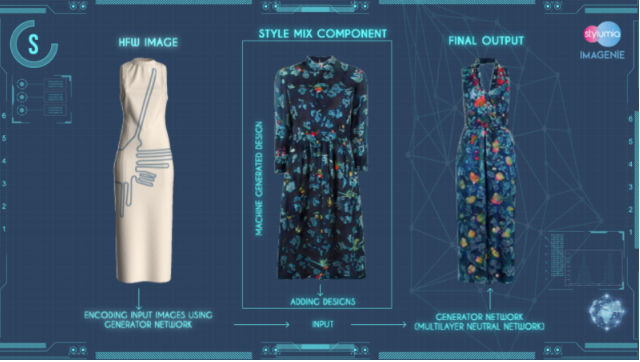It's 2021, 5G networks are here, and artificial intelligence (A.I) is slowly becoming part of our lives. A.I is no longer only in the movies; it's also now a tool for fashion designers to improve how they operate. With ever-changing trends and a consumer base that demands both quality and ease, the fashion industry is turning to artificial intelligence for help. Social media A.I in particular, has established a gold mine of global data that reveal endless possibilities for both fashion brands and consumers to optimise product preference, service customisation, error reduction, fashion trend prediction, and more.
In this blog, we will look at how artificial intelligence (A.I) is altering and will shape the fashion industry. It will help emerging designers move to the top of their game and result in less working time and workload for new designers. The sky's limit with A.I Even with social distancing and pandemics, they will help shape the way consumers shop. As an emerging fashion designer with selective resources, A.I will be a significant helper in pushing fashion design to consumers more directly and efficiently than ever before.
The following three tools for fashion designers demonstrate how fashion designers can use A.I to drive design, trend forecasting, and how consumers perceive and purchase fashion merchandise.
A Tool That Optimises Apparel Trends and Fashion Business Management

Stylumia is a B2B platform that promotes sustainable fashion startups by using deep learning, computer vision, and prediction algorithms. Stylumia believes that people and businesses in fashion and lifestyle retail can tackle complex challenges and change the world with the appropriate data and technology. This tool predicts customer trend demand and future upcoming fashion trends. It also assists designers with inventory management and improving business impact decisions.
Data from ERP (Enterprise Resource Planning) systems associated with behavioral knowledge in demand forecasting often fail to take advantage of what the data indicates. Stylumia creates demand forecasts based on customer behavior online. It collects data from various sources, including website crawling and data from online runway shows. Stylumia can discover pricing and demand trends down to specific channels and tracks using this data, regardless of whether niche or mass-market. Unlike the traditional market research methods that have delay, Stylumia provides accurate data that can digitally connect to practically any data source without any hesitation. The proprietary algorithms then turn the data into insights and predictions. Its artificial intelligence features even help shoppers with their online shopping experiences. It does this by increasing human intelligence in fashion and lifestyle retail.
Data from ERP (Enterprise Resource Planning) systems associated with behavioral knowledge in demand forecasting often fail to take advantage of what the data indicates. Stylumia creates demand forecasts based on customer behavior online. It collects data from various sources, including website crawling and data from online runway shows. Stylumia can discover pricing and demand trends down to specific channels and tracks using this data, regardless of whether niche or mass-market. Unlike the traditional market research methods that have delay, Stylumia provides accurate data that can digitally connect to practically any data source without any hesitation. The proprietary algorithms then turn the data into insights and predictions. Its artificial intelligence features even help shoppers with their online shopping experiences. It does this by increasing human intelligence in fashion and lifestyle retail.
The A.I-Based Service with Algorithms That Improve Client Shopping Satisfaction
Stitch Fix is a personal styling service that chooses clothing styles on behalf of customers. This individual style provider sends a tailored suggestion of reasonably priced products to customers' doors throughout the country. Stitch Fix is able to make suggestions well suited to its clients thanks to artificial intelligence-based algorithms that identify trends and designs using a combination of customers' favorite colors, patterns, and materials. Stitch Fix achieves a wholly tailored experience for the customers.
Stitch Fix's mission is to save consumers' time by making them look fantastic and improve their style over time. Katrina Lake founded Stitch Fix to combine the human aspect of personal styling with high-quality apparel and proprietary algorithms. While attending Harvard, she mailed the first Stitch Fix order from her Cambridge flat in 2011. The company has since expanded to serve millions of men and women around the country.
Stitch Fix’s subscription-based platform and feedback-focused business strategy has collected massive troves of client data. According to the company, artificial intelligence was used in the design process of each customers’ style, and the company employs more than 120 people to oversee the machine learning algorithms that guide everything from client styling to logistics and inventory management.
Digitising Traditional Haute Couture With A.I

The Synflex team is symbiotically redesigning fashion using artificial intelligence. Their products, termed Algorithmic Couture, aim to democratise haute couture customisation by revitalising personalisation in the digital design process. This service uses machine learning algorithms to create an optimum modular patterned clothing (clothing with detachable pieces that the wearer can add or leave off to alter the clothing style, fit, or construction) so that the customer can have ultimate control over the structure, fabric, and color of their outfits. Modular fashion helps the consumer easily alter the clothing item to suit changes needed over the trend period. Not only does it help to adjust the style, but the reassemblies also allow easy removal and replacement of any damaged parts of the clothes instead of requiring an entirely new outfit purchase.
At its core, Synflex’s initiative has three primary concepts: firstly, sustainability, which it achieves through a claimed zero-waste fashion design process; second, digitising the traditional haute couture processes into an automated digital fabrication production system, which it does by transferring classic haute couture techniques into parameters for an automated digital fabrication production system; and finally, personalisation, which it offers to buyers through body data informed customisation of bespoke clothes.
Synflex’s optimum fashion patterns are derived from machine learning algorithms, body dimensions, and configurable design parameters. Rectangles and straight lines make up the optimum pattern-cutting procedures, enabling fabric placement optimisation via genetic algorithms. While Synflex accomplishes this using in-house technology, this can give emerging designers an idea of how they may be able to one day develop proprietary tech software for their brand and expand the realms of possibility beyond the traditional ways of making clothes.
How AI Shapes Creative Digitalisation in the Fashion Industry

As you read through this blog, consider developing or using a new technology to aid your fashion brand’s development and growth. Naturally, as the world's population increases, the need for apparel and the waste from fashion consumption will continue to reach higher than ever. Thanks to emerging fashion tech and A.I. tools like those above, the linear approach based on mass production and consumption can now change to create a more sustainable future that treats fashion cycles more holistically
A fashion designer can reduce fabric loss during the fashion pattern design process by rethinking the process using Synflex's Algorithmic Couture tools. Collaborating with or using services such as Stylumia gives emerging fashion designers the chance to grow their brand faster and better predict successful trends in business and design. By looking at how we can digitise more processes in fashion, we can realign our incentives toward more sustainable values. As A.I "Support" systems improve, brands will be able to make more informed strategic decisions about product development, new business lines that protect their bottom dollar, and further any sustainability goals they have as businesses.
This article has not been edited by Fibre2Fashion staff and is re-published with permission from makersvalley.net










Comments